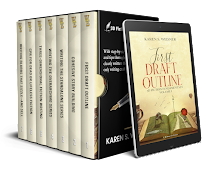Recently I've read several bestselling first-person, canine-viewpoint novels by W. Bruce Cameron, the trilogy A DOG'S PURPOSE, A DOG'S JOURNEY, and A DOG'S PROMISE, plus a stand-alone book, A DOG'S WAY HOME. (I've watched three movies adapted from them, too, and I recommend those films. They stick as close to the novels as practicable within their running times.) The latter is realistic, aside from the literary convention of having the canine protagonist narrate her experiences in articulate, grammatical English. The author's afterword mentions the extensive research he did to ensure that her 400-mile cross-country travels would be plausible and also discusses two important motifs in the story, breed-discriminatory legislation and therapy dogs for veterans. The trilogy is fantasy, since it deals with a dog's many lifetimes, reincarnated over and over as he/she strives to fulfill his/her purpose. (Even if I believed in reincarnation, I'd classify these novels as fantasy, since we have no way of knowing what the afterlife is like or exactly how the rebirth process would work.) These books portray the world through a dog's mind and senses, smell and hearing preternaturally acute by our standards, but an understanding of human words and actions necessarily limited. The canine narrator acts like a living video and audio recorder. He or she sees and hears everything that goes on within sensory range, but a lot of it goes over the dog's head. Therefore, the reader understands what's happening even when the narrator doesn't. The dog recognizes many words but is often puzzled by the context. For instance, why do people frequently mention the names of other people who aren't present? Why don't humans appreciate the importance of chasing squirrels or checking out intriguing scents? In a funny scene in one of the books, the dog thinks his owners are encouraging him to bark louder when they yell at him to stop barking. The dogs in Cameron's works don't talk among themselves. They infer the moods, motives, and emotions of other dogs from smells, nonverbal vocalizations, and body language. I highly recommend these novels. Yes, they're tearjerkers with sentimental happy endings, but I love that if it's done well, and the human characters have believable, non-trivial problems.
Fictional animal autobiography goes back at least to BLACK BEAUTY in 1877 (and earlier, according to Wikipedia). Again, the horse narrator tells his life story within a framework of equine perceptions and concerns. Human actions are described and interpreted as they directly affect him. Like Cameron's dogs, he and his animal companions don't talk. Aside from having a horse tell the story, BLACK BEAUTY sticks to events that could actually happen. Indeed, the author's principal purpose was to awaken people to the real-life sufferings of horses and incite reforms in the treatment of animals.
There's a similar level of animal verisimilitude in BAMBI (Felix Salton's novel, not the Disney animated film). The main difference is that the deer do converse verbally. Otherwise, they behave like normal woodland creatures.
The rabbits in WATERSHIP DOWN represent a step away from completely naturalistic wildlife behavior. They have not only a language but culture and mythology. The author, however, researched the actual lives of rabbits, making his characters behave like their nonfictional models. For example, extreme fear can make them go "tharn," paralyzed with terror.
Diane Duane's feline wizard trilogy, THE BOOK OF NIGHT WITH MOON, TO VISIT THE QUEEN, and THE BIG MEOW (the latter available only through the author's website), being fantasy, depart further from strict realism. This series features cat wizards with human-like intelligence and a complex feline language. Nevertheless, aside from their wizardly duties, they view the world and human society from a feline viewpoint. For instance, they make a sharp distinction between neutered and sexually active members of their species, and intact males, even cat wizards, still act like tomcats.
On the opposite end of the spectrum from BAMBI and Cameron's dog stories, we have books such as George Orwell's ANIMAL FARM. Although the pigs and other farm inhabitants retain many animal traits, they essentially serve the function of satirizing human political structures rather than attempting to portray the actual lives of domestic livestock.
At its best, deep-dive immersion animal viewpoint fiction can allow the reader imaginative access to minds unlike our own that we can nevertheless empathize with.
Margaret L. Carter
Carter's Crypt



































